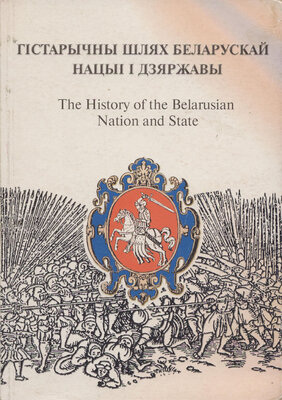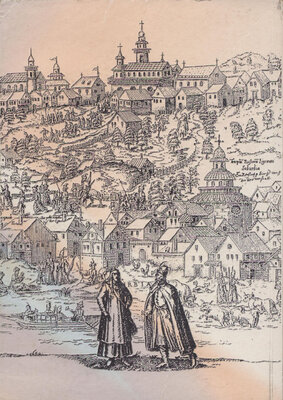Гістарычны шлях нацыі і дзяржавы
Радзім Гарэцкі, Міхась Біч, Уладзімір Конан
Выдавец: Беларускі кнігазбор
Памер: 348с.
Мінск 2001
Графіці палачаніна Ваінега Жураговіча на сцяне Сафіі Кіеўскай Graffito by Vainieh Zhurahovich on a wall of St Sophia Cathedral in Kiev
Алавяны абразок XII ст. з Турава Tin icon from Turau, the Xllth c
Кірыла Тураўскі Kiryla Turauski
Адзігітрыя Полацкая Virgin with the Child Polatskaya
jjTpTAtrb прптулcнг&тлькг »КТЛН I TB Qp H B t YUU ^<1 ььлмііvnrRa многгі 7$ Нпб;л<* phETic ьомвгодь ^OBtXtC A LtlUHtBA MTlMT
HMТІ hld ІГГ? т0 BД MO ЕЧТЬШ ЦГІДХДША&КІГ П±ВЛМ G0fi’tY4T»HA Д-І I НйТкупмДТС€ДОНМДМ'Ь N if ?n w KWH T H Й B H TH ^НМОЛіЛапМІіША coptriaдругынре^^ Hvn 9 nГТ H 11 rOftA ДНТП мЬгріУрмтнііппншш pAFvnoatAArnipm МіГ.ТОГ^ЛййГГпІБА UUtC^rHTAOMVHf Yt p A E If C B 0 ft M If Mtn * Ko рВЛгАІПуТЬЙгЛГТ& тм’ытгаддднмшлілм б4 AHTlMCd^ ПТЛгАМДО мт і ri» бтвгдм c*k mo^h pV oak^th рті гд Komtm ь Mm rt ш t M’t cTQum npTHT ЬАЕЛHL HAHHA ntr TH TQA ДД H nc ri If Д M Б CA kA HA П 0 Л ННТІАД0 М’ЬМОМКЛТ глЬеойа UT ra KO П M ЛД H twin M If л ЬТ^ XТіГ Б A MTS XT ntbKyrHMOtmKfcYtpA *Л M Q GT Ліі t If тьЛ A ri H H
finonT ’p «AlfпамНч/пмнм
Ж^м± YM HKQ K ru {ЛДIf H • HVETI
■ЙлЖтн ECК6П HK H прд ШДДУТЬГЛШІОІГТН тІлттойс± нпстьнапм САЛТПА ІЛТ1АШІК0 MV 4у мрtтьбьа мЬгы н <гче ПІгН’Г’ЬОумреТЬЕІЦЛЙ демт-ДдпонкдетьБйЛт^ ft М у /Т\ t Ну ft г 0 n BT t ТА В МТЬ П A t/я A ЕIA т Jf£bO
му • с ед ІЛЬ 0 if Б 0 Брн Е'іА-мпокмттемЬн aifMpEt Wd AtHT МЕТв p Т i н п о н m л\ан if п т т ОуКЛр^ЕЕШАНЧн-Г-ПОМ MIMTA К 0/T\t М ЕСА? ЬДМ ПОМрвШДПеОІТДЕЛЬШЕ YAATПОСЛ^ДЬ^ЕвТ&Н пй П Д оу ЛД 0 Ь В1) ь йміппе О1ЛЕО Koh-o ІАП ElfAtTL ?nb HA с t Д Mb ГО НМІ шд Ai new«Б± шя ВТІСЬ ptMMTCribt ЕТМАСЕГО ІГчЕМАТСЖН ПОСАГ4 П)ТЬ АСПОЛ0 ельшннсаб^ггь 0 НТПІДІ/ТНТН B’bBCKpt м n a а н г м р тігь і X т
пнте паТгайнлосаіэ
Евангелле XII—XIV стст. з полацкага манастыра Іаана Прадцечы Gospel of the Xllth—XIVth c from Joan the Baptist monastery in Polatsk
Францішак Скарына Frantsishak Skaryna
Тытульны аркуш «Бібліі» Францішка Скарыны Title page from Frantsishak Skaryna’s Bible
Псалтыр Ф. Скарыны Psalter by F. Skaryna
Сымон Будны Гравюра XVI cm.
Symon Budny
Engraving of the XVIth c
Васіль Цяпінскі Гракюра XVI cm.
Vasil Tsiapinski Engraving of the XVIth c
K^THKHSIC'b TO EGT5, HAW GTAPOAASHAhl ХРІСТІАЯЬ GKAH W GSETOrO ПНСМ^,ЛЛН ПРО 6ТЫХК ЛЬД-Еі HSKlKAf^ ОКОГО165ПЫТАЙІАХ5»СО.
КАЗШСЗШНА»
(0ПЕРШГ0 GSETOrO АПОСТОДЯ ПіТ^ПОСААНІА ЗЛШО £•
Готосн прнно кг всдком\[ вг п^іп»Юфім^ «ы ,
woto doutfMT йлоінмім СiKfcmocmію н
со<4<тьнм^і ьлг^ н проімА*
«Катэхізіс» Сымона Буднага. 1562 г.
Catechism by Symon Budny, 1562
Царква абарончага тыпу ў Сынкавічах. XVI ст. Church-fortress in Synkavichy, the XVIth c
Замак y Міры. Канец XV — пачатак XVI ст. Літаграфія з гравюры Н. Орды
Castle in Mir, the late XVth — early XVIth c Lithography from the engraving by Napaleon Orda
Ратуша ў Магілёве. XVII ст. Town hall in Mahiliou, the XVIIth c
Гарадская пячатка Магілёва. 1661 г.
Municipal seal of Mahiliou, 1661
Супрасль. Адзін з цэнтраў беларускага летапісання XVI ст. Suprasl in the XVIth c, a centre of chronicle writing in Belarus
Дктоікігі .
HAO0HM6
Д* ЛЫ . рКІГ , A $ ЛА .
Евангеліст Лука Гравюра з выдадзенага ў віленскай друкарні Мамонічаў Евангелля. 1575 г.
Evangelist Luka Engraving from the Gospel printed in Vilnya in the printing house of the brothers Mamonich, 1575
Тытульны аркуш кнігі «Трыбунал Вялікага Княства Літоўскага». 1586 г. Title page of the book Tribunal of the Grand Duchy of Lithuania, 1586
Драўляная скульптура: Архангел Міхаіл, сярэдзіна XV ст.; Марыя з дзіцем, канец XVI ст.; прарок Захарыя. XVII ст.
Wooden figures: archangel Mikhail, the middle XVth c; Maria with the Child, the late XVIth c; prophet Zakharyia, XVII th c
Баркулабаўскі летапіс. Спіс XVII ст. Barkulabau chronicle, the XVIIth c
Багародзіца Адзігітрыя Неўвядальны цвет. XVII ст. Virgin with the Child the Unfading bloom, the XVIIth c
Аляксандр Тарасевіч. Сакавік Гравюра. 1678 г.
March
Engraved by Aliaksandr Tarasievich, 1678
Васіль Вашчанка. Каляды. 1730 г.
Christmas, by Vasil Vashchanka, 1730
«Жыцці святых». Магілёў. Друкарня М. Вашчанкі. 1702 г. Lives of the Saints. Printing house of M. Vashchanka, Mahiliou, 1702
Сімяон Полацкі Simiaon Polatski
Святыя Аўрам і Мяркурый Смаленскія Saints Auram and Miarkury of Smalensk
Вокладка «Вертограда многоцветнага» Сімяона Полацкага Cover of the book by Simiaon Polatski
Уршуля Радзівіл Urshulya Radzivil
Міхал Казімір Агінскі
Mikhal Kazimir Ahinski
Слуцкі пояс Slutsk girdle
Сцэна са спектакля «Несумленнасць у пастцы» Уршулі Радзівіл Гравюра 1751 г.
Scene from the play Dishonesty Caught in a Trap by Urshulya Radzivil Engraving of 1751
Напалеон Орда Аўтапартрэт Napaleon Orda Self-portrait
Рэктар Віленскага універсітета Вацлаў Пелікан Vatslau Pelikan, Rector of the Vilnya University
Бялынічы
Літаграфія H. Орды Bialynichy Lithography by Napaleon Orda
Адам Міцкевіч Adam Mitskievich
Ян Чачот
Yan Chachot
Ян Баршчэўскі Yan Barshcheuski
Валенці Ваньковіч
Valientsi Yankovich
Уладзіслаў Сыракомля Uladzislau Syrakomlya
Вінцэнт Дунін-Марцінкевіч
Vintsent Dunin-Martsinkievich
Янка Лучьіна
Yanka Luchyna
Францішак Багушэвіч
Frantsishak Bahushevich
Янка Купала Yanka Kupala
Цётка (Алаіза Пашкевіч) Tsiotka (true name Alaiza Pashkievich)
Якуб Колас
Yakub Kolas
Максім Багдановіч
Maksim Bahdanovich
Трупа Ігната Буйніцкага Troupe of Ihnat Buinitski’s theatre
Ігнат Буйніцкі Ihnat Buinitski
Мітрафан Доўнар-Запольскі Mitrafan Dounar-Zapolski
Максім Гарэцкі
Maksim Haretski
Міхась Чарот
Mikhas Charot
Браніслаў Тарашкевіч Branislau Tarashkievich
Ларыса Геніюш Larysa Hieniyush
Мастацкая секцыя Радашковіцкай беларускай гімназіі імя Францішка Скарыны. У першым радзе другі справа — Язэп Драздовіч. 30-я гг.
Art group of the Frantsishak Skaryna Belarusian gymnasium in Radashkovichy. Yazep Drazdovich is in the first row, the second from the right, the 1930s
Міхал Забэйда-Суміцкі
Mikhal Zabeida-Sumitski
Уладзіслаў Галубок Uladzislau Halubok
Наталля Арсеннева Natalya Arsienieva
Кузьма Чорны Kuzma Chorny
Народны паэт Беларусі Максім Танк Maksim Tank, the People’s Poet of Belarus
Уладзімір Караткевіч Uladzimir Karatkievich
Народны пісьменнік Беларусі Васіль Быкаў Vasil Bykau, the People’s Writer of Belarus
CULTURE
Despite the great difficulties we had to overcome; the hardship we suffered; and the great number of Belarusian people who fell in wars, the nation continued to survive. Once again the Belarusians restored their Motherland to life; they gave birth to and brought up children; so the numerous generations were linking time and history together; they carried through the centuries the burning fire of life. Our people also created and developed our unique national culture; they developed and mastered literacy and, thus, acquired knowledge.
The Polatsk principality can be considered the cradle of the Belarusian national culture. The Polatsk princes promoted Christianity, and it brought knowledge, education, and European cultural achievements. The son of Rahnieda, the Prince of Polatsk Iziaslau introduced literacy and primary education. That is why, Iziaslau was the first of the Western Slavic princes to be named knizhnik {booklover). A seal with his name is considered to be the oldest monument of Belarusian literacy (next to the dish with the word ‘Horoushna’ found near Smalensk) and a second one among Western Slavs.
In the 50s of the Xlth century St Sophia Cathedral was erected by Prince Usiaslau Charadzei (Usiaslau the Magician) in Polatsk. The Cathedral with its unique architecture established the same cultural and political value as the Sophias of Kiev and Novgorod. Being the symbol of national statehood, it went through every collision of Belarusian history often ruined but always rebuilt in new beauty. And now the stately white temple of ancient Polatsk seems to flow over the Dzvina to eternity, and its unique beauty is attracting people from all over the world.
A granddaughter of Usiaslau Charadzei followed the glorious traditions of her family. Young princess Pradslava, in order to serve the Lord and the people of her country, took the veil and the name of Euphrasinia Polatskaya. She happened to be the first woman in Eastern Slavic lands to be ranked as a Saint by the Church. Thus, St Euphrasinia Polatskaya forever established her name in history. She spread education, translated and copied a number of books, founded both a monastery and a convent in Polatsk; schools, scriptoriums, libraries,
and icon workshops were opened with her assisstance. At present both Orthdox and Catholic believers honour St Euphrasinia as a patron of Belarus and our intercessor before the Lord.
Ordered by St Euphrasinia, a unique masterpiece of jewelry, the Life-Giving Cross, was created by master Bohsha (or Lazar by Christian name) in 1161. The Cross became a spiritual symbol of Belarus. But this treasure was moved out of the country during World War II, and it is still impossible to know where it is now. An accurate copy of the Cross was created not long ago by master Mikola Kuzmich working on the initiative of the International Association of the Belarusian people ‘Batskaushchyna’ as well as the Belarusian Orthodox church and the state. The copy of the Cross is kept at Spasa-Euphrasinia Church in Polatsk built by a Polatsk man of genius laan in the days of St Euphrasinia Polatskaya.
Moreover, in the Xllth century the Turau principality was one of the big cultural centres of Belarus. And it became famous partly because of the enlightenment work and the very life of Bishop Kiryla Turauski. He was the author of a number of sermons, prayers, and canons, that played an important role in the spiritual life of our people. The works by Kiryla Turauski were read, learnt by heart, and copied in every Eastern Slavic state. He was named the other Zalataslou (Brilliant writer and speaker), who was ‘head over shoulders above the others in Russia’.
Smalensk in the Xllth century was also famous for its talented writer, enlightener, and teacher Klim Smaliatsich. Together with his follower Auram Smalenski they were among the most educated people of that time.
 КНІГІ ОНЛАЙН
КНІГІ ОНЛАЙН


